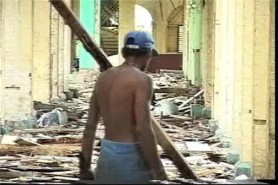– almost completely vandalized, residents say
Despite calls being made for the preservation of the historical old New Amsterdam Hospital building, vandals are still destroying it and residents are afraid that the dilapidated structure could collapse at anytime.

They noted that soon after the commissioning of the new New Amsterdam Hospital on February 20, 2005 vandals started to dismantle the old edifice.
They had been removing boards, zinc sheets, sinks, cupboards and electrical and pipe fittings from the old structure during the night. But now, residents said, “They are doing it in broad daylight without fear of being caught.”
They said too that recently vandals have started breaking into their homes and removing articles as well.
“We want the police to keep these junkies out of the area because we do not feel safe in our own homes. They coming to steal from us because they are not satisfied with what they are getting at the hospital…,” the residents lamented.
According to them, “If the government did not want the building to be destroyed they should have done something about it. That is an historic site and they should have preserved it instead of allowing it to go to waste like that.”
The building is also a haven for vagrants who would curse and smoke in it and residents said it poses a serious fire hazard. They told this newspaper that “if a fire should break out there it would spread quickly.”
At a recent press conference in Berbice, Minister within the Ministry of Health, Dr Bheri Ramsarran said it was “regrettable” that vandals were damaging the building “but probably that is a reflection of some wider values in the society.”
He said the ministry was “looking forward to the positive” and “would continue to strengthen that new hospital” until decisions are made regarding the old building.
The minister said the new US$13 million hospital has been “proving its worth” and that government has added more services to it.
He said the old structure has “lost its usefulness as a centre for delivering modern medical services” and that the new facility has been strengthened by several young Guyanese doctors who studied in Cuba.
This newspaper was there recently as a vandal was carting away materials and when asked what he was doing responded, “…poor people gat to live. As long as the police don’t fight we down everything gat fuh move”.
The man who was removing the materials to sell said too, “Even if they want to fight we down; people gon still thief [the materials] and it [building] gon still break.”
According to him “millions of dollars” in materials have already been removed and “government ain’t care nothing… ah give this hospital two weeks more and it gon fall.”
The new building, funded by a grant from the Japanese government and built by the Kitano Construction Company is equipped with modern facilities.
History
The old building is a timber architectural masterpiece that was designed by world renowned architect, Cesar Castellani in 1881 and officially opened in 1884.
Pastor Wilbert Daniels who is advocating the preservation of the building had told this newspaper, “If the building stands as a monument it should not be left empty but the space should be utilized for the establishment of a library and a [medical] museum.
“It is my desire to see it restored” and suggested that persons visiting the museum could be charged a fee for the maintenance of the building.
Noting that the exercise would be costly, Daniels had pointed out that another option was for government to “get persons to utilize sections of the building and their mere presence can act as a form of security and keep away the vagrants.”
A brief history of the hospital states that an extension which started from the western end of the building in 1925 and was completed in 1926, served as the tuberculosis ward on the bottom flat and a maternity ward on the top flat.
The x-ray department was established in 1928 and an x-ray machine was purchased and installed. The other x-ray department was opened in December 1966.
The nurses’ dining room was built and a small laboratory was erected in 1932. Further additions were done to the building in 1950.
There was no adequate water supply and rainwater had to be collected and stored in large tanks and then pumped into the wards. The water system was improved in 1952 when an artesian well was sunk.









